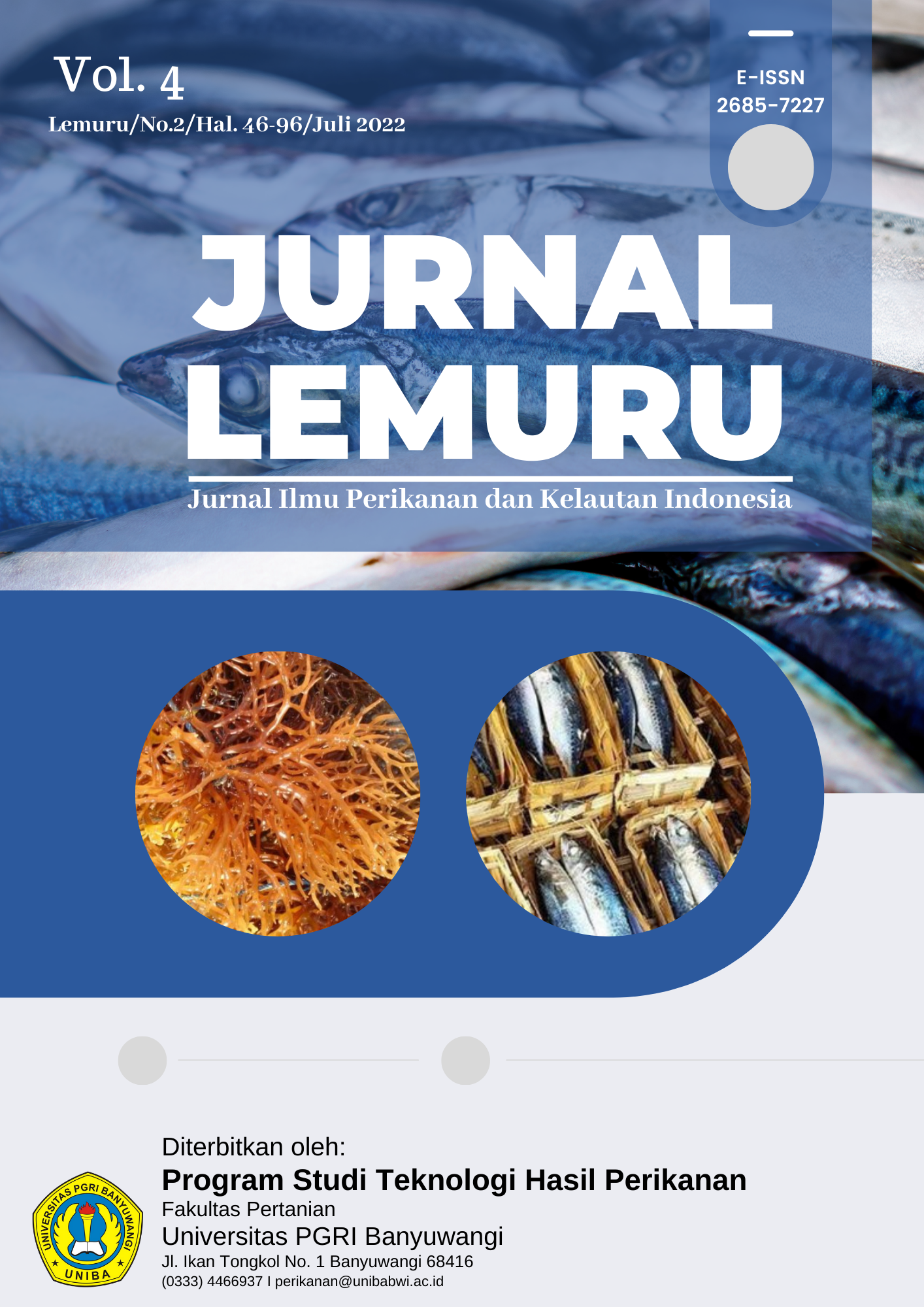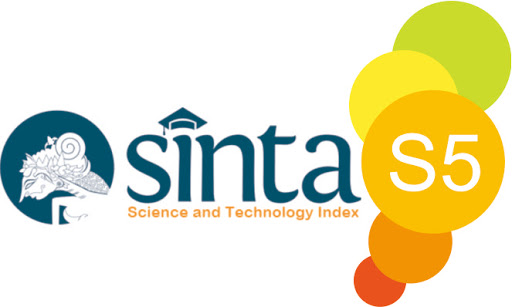KARAKTERISASI BIOAKTIF EKSTRAK Eucheuma cottonii DI PERAIRAN DESA SUMBERKENCONO, BANYUWANGI
DOI:
https://doi.org/10.36526/lemuru.v4i2.2105Keywords:
Karakterisasi, Makroalga, Bioaktif, E. cottoniiAbstract
Rumput laut merah jenis Eucheuma cottonii merupakan jenis alga yang melimpah dipesisir pantai banyuwangi. E. cottonii memiliki manfaat yang besar untuk industri makanan maupun industri farmasi. Hal tersebut terkait dengan komposisi kandungan zat yang ada di dalam E.cottonii berupa fitokimia. Penilitian ini bertujuan untuk mengetahui kandungan bioaktif berupa fitokimia yang ada pada ekstrak E. cottonii. Melalui metode ektraksi dengan maserasi menghasilkan ekstrak E. cottonii. Hasil yang diperoleh dari penelitian berupa fitokimia yaitu pada E. cottonii memiliki kandungan alkaloid, flavonoid, terpenoid dan saponin.
References
Dahm H. U., and Sergey, D. 2017. Antifouling Compounds from Marine Macroalgae. Marine Drugs. 15(9): 265-281.
Ezeonu, C. S., and Ejikeme, C. M. 2016. Qualitative and Quantitative Determination of Phytochemical Content of Indigenous Nigerian Softwoods. New Journal of Science. Vol. 2016: 1-9. http://dx.doi.org/10.1155/2016/5601327
Ganesan, A. R., Tiwari, U., and Rajauria, G. 2019. Seaweed nutraceuticals and their therapeutic role in disease prevention. Food Science and Human Wellness, 8(3),
252–263. https://doi.org/10.1016/j.fshw.2019.08.001
Harborne, J. B. 1996. Metode Fitokimia: Penuntun Cara Modern Menganalisis Tumbuhan. diterjemahkan oleh Kosasih P dan Imam S. Edisi II. ITB: Bandung.
Kittakoop, P., Mahidol, C., and Ruchirawat, S. 2014. Alkaloids as important scaffolds in therapeutic drugs for the treatments of cancer, tuberculosis, and smoking
cessation. Current Topics in Medicinal Chemistry, vol. 14, no. 2, pp. 239–252, 2014.
Nazla and Nadhifah, F. 2016. Ekstraksi Senyawa Fitokimia Dari Alga Eucheuma Cottonii Dan Glacilaria sp Menggunakan CO2 Superkritis Dengan Ethanol Sebagai
Entrainer. Fakultas Teknologi Industri Institut Teknologi Sepuluh Nopember Surabaya:Surabaya (Hal:10)
Purba, N. P., Pranowo, W. S., Ndah, A. B., and Nanlohy, P. 2021. Seasonal variability of temperature, salinity, and surface currents at 0° latitude section of Indonesia seas. Regional Studies in Marine Science, 44, 101772. https://doi.org/10.1016/j.rsma.2021.101772
Puspawati, S., Wagiman, Ainuri, M., Nugraha, D. A., and Haslianti. 2015. The Production of Bioethanol Fermentation Substrate from Eucheuma cottonii Seaweed through Hydrolysis by Cellulose Enzyme. Agriculture and Agricultural Science Procedia, 3, 200–205. https://doi.org/10.1016/j.aaspro.2015.01.039
Qiu, S.,Sun, H., and Zhang, A. H. 2014. Natural alkaloids: basic aspects, biological roles, and future perspectives,” Chinese Journal of Natural Medicines, vol. 12, no.
6, pp. 401–406, 2014.
Sami, F. J., Suekamto, M. H., Firdaus., dan Latip, J. 2019. Uji Aktivitas Antioksidan Ekstrak Alga Coklat Sargassum polycystum Dan Turbinaria deccurens Asal Pulau Dutungan Sulawesi Selatan Terhadap Radikal Dpph. Jurnal Kimia Riset. Vol. 4 No. 1.
Sari D. K., Dyah H. W., dan Aji P. 2013. Kajian Isolasi Senyawa Fenolik Rumput Laut Eucheuma cottonii Berbantu Gelombang Micro Dengan Variasi Suhu dan Waktu. Jurnal Teknik Kimia. Vol 9. No. 3: 38-43.
Sheikh, N., Kumar, Y., Misra, A. K., and Pfoze, L. 2013. Phytochemical screening to validate the ethnobotanical importance of root tubers of Dioscorea species of
Meghalaya, North East India,” Journal of Medicinal Plants Studies, vol. 1, no. 6, pp. 62–69
Taylor, G. T. and Zheng, D. 1995. Natural products for mitigation of fouling by the blue mussel, Mytilus edulis, in marine water intake system in Proceedings of The Fifth International Zebra Mussel and Other Aquatic Nuisance Organisms Conference, Toronto, Canada: 447-454.
Tsukamoto, S., Kato, H., Hirota, H., and Fusetani, N. 1997. Antifouling terpenes and steroids against barnacle larvae from marine sponges. Biofouling: The Journal of Bioadhesion and Biofilm Research. 11(4): 283-291.
Wouthuyzen, S., Herandarudewi, S. M. C., and Komatsu, T. 2016. Stock Assessment of Brown Seaweeds (Phaeophyceae) Along the Bitung-Bentena Coast, North
Sulawesi Province, Indonesia for Alginate Product Using Satellite Remote Sensing. Procedia Environmental Sciences, 33, 553–561. https://doi.org/10.1016/j.proenv.2016.03.107
Downloads
Published
How to Cite
Issue
Section
License
Copyright (c) 2024
This work is licensed under a Creative Commons Attribution-ShareAlike 4.0 International License.











